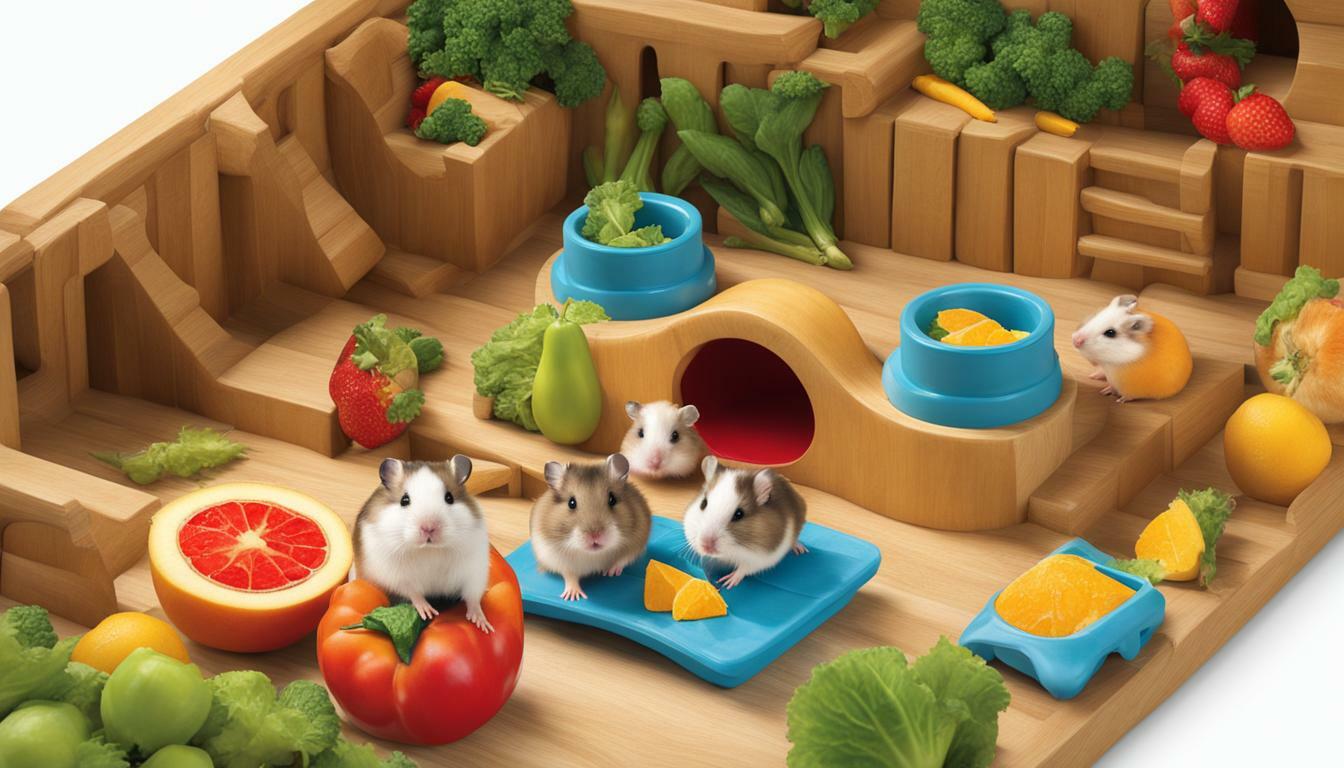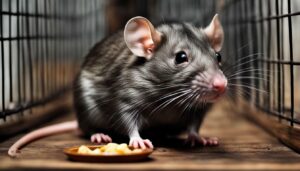If you’re curious about how long hamsters can live and which breeds have the longest lifespan, you’ve come to the right place. Hamsters are adorable little creatures, but they unfortunately don’t have the longest lifespans due to their small size and fast heart rate. However, there are certain breeds that tend to live longer than others. Let’s dive into the world of hamster lifespans and discover which hamsters live the longest!
- The Syrian hamster breed tends to live the longest among pet hamsters
- The European hamster, also known as the Black-Bellied or Common Hamster, has the longest lifespan in captivity, up to 8 years
- The Roborovski Hamster has the longest lifespan among pet hamsters, averaging 26 months in captivity
- Factors affecting hamster lifespan include genetics, diet, exercise, and overall care
- Providing a well-balanced diet, ample exercise space, proper cage size and cleanliness, and regular veterinary check-ups can help increase a hamster’s lifespan
The Longest-Living Hamster Breeds
Among the various hamster breeds, some are known for their remarkable longevity, with one breed standing out as the longest-living among pet hamsters. When it comes to hamsters, the Syrian breed tends to live the longest. These adorable creatures can live up to 3 years when cared for properly.
Another breed with an exceptional lifespan is the European hamster, also known as the Black-Bellied or Common Hamster. In captivity, these hamsters can live up to 8 years. However, it’s important to note that this breed is not commonly kept as a pet.
One popular pet hamster breed that also boasts a longer lifespan is the Roborovski Hamster. These tiny, energetic hamsters can live for an average of 26 months in captivity. Despite their small size, they have a relatively longer lifespan compared to other hamster breeds.

The Longest-Living Hamster Breeds
| Breed | Average Lifespan |
|---|---|
| Syrian Hamster | Up to 3 years |
| European Hamster | Up to 8 years |
| Roborovski Hamster | Up to 26 months |
While these hamster breeds have the potential to live longer, it’s important to remember that hamsters, in general, have relatively short lifespans due to their small size and fast heart rate. However, there are steps you can take to help increase their lifespan.
Factors such as genetics, diet, exercise, and overall care play a crucial role in a hamster’s lifespan. Providing a well-balanced diet, access to fresh water, ample exercise space, proper cage size and cleanliness, and regular veterinary check-ups can contribute to a longer and healthier life for your furry companion.
The European Hamster’s Exceptional Lifespan
While not typically kept as pets, the European hamster deserves a mention when discussing hamster lifespans due to its exceptional lifespan in captivity. Also known as the Black-Bellied or Common Hamster, this breed has been known to live up to 8 years, making it the longest-living hamster in captivity.
This small, nocturnal mammal is native to Europe and is often found in agricultural fields and grasslands. It has a distinctive appearance with gray fur, a black belly, and large cheek pouches for storing food. Despite its long lifespan, the European hamster is not commonly kept as a pet due to its specialized needs and limited availability in the pet trade.
With a heart rate of 450 beats per minute, hamsters generally have a fast metabolism and shorter lifespans compared to larger mammals. However, the European hamster has evolved to live longer, possibly due to its hibernation habits and ability to slow down its metabolic rate during the winter months. This unique adaptation allows it to conserve energy and extend its lifespan.

When considering the lifespan of hamsters, it’s important to note that individual care and environmental factors play a significant role. Factors such as genetics, diet, exercise, and overall care can greatly influence a hamster’s lifespan. By providing a well-balanced diet that includes fresh fruits, vegetables, and high-quality hamster pellets, you can ensure that your pet is receiving the necessary nutrients for a longer and healthier life. Additionally, providing ample exercise space, a clean and appropriately sized cage, and regular veterinary check-ups are crucial for maintaining your hamster’s well-being and maximizing its lifespan.
The Longevity of Roborovski Hamsters
If you’re in search of a pet hamster with an impressive lifespan, the Roborovski Hamster may be the perfect choice for you. This breed is known to have the longest lifespan among pet hamsters, with an average of 26 months in captivity. Although hamsters, in general, don’t live very long due to their small size and fast heart rate, Roborovski Hamsters are an exception to this rule.
Roborovski Hamsters, also known as Robos, are native to the deserts of Mongolia, China, and Russia. These tiny creatures have captured the hearts of hamster enthusiasts worldwide with their energetic nature and adorable appearance. Despite their small size, Robos have a big personality and can provide endless entertainment and companionship.
One of the reasons why Roborovski Hamsters have a longer lifespan than other pet hamsters is their genetics. They have a strong constitution and are less prone to certain health issues that can affect other breeds. Additionally, providing them with a well-balanced diet, access to fresh water, and ample exercise space are crucial for their overall well-being and longevity.
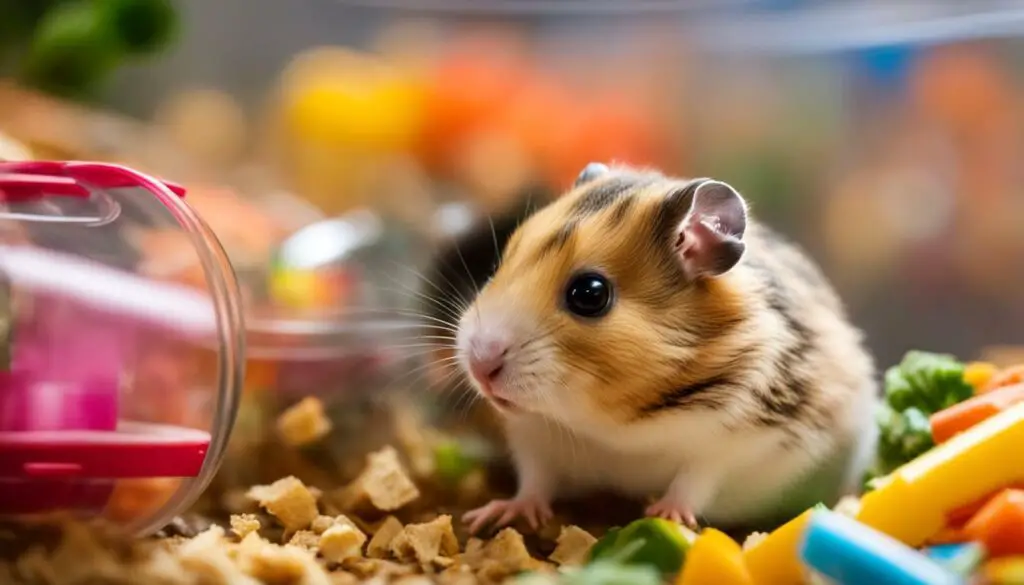
When it comes to their housing, Robos need a properly sized cage that allows them to explore, burrow, and play. Ensuring a clean and hygienic environment is essential to prevent any potential health issues. Regular veterinary check-ups are also important to monitor their overall health and catch any potential issues early on.
In conclusion, while hamsters are generally known for their short lifespans, Roborovski Hamsters stand out with their impressive longevity. By providing them with proper care, a well-balanced diet, and a suitable living environment, you can help ensure that your Robo companion lives a long and healthy life.
Factors Affecting Hamster Lifespan
Several factors play a crucial role in determining a hamster’s lifespan, and by understanding and addressing them, you can help extend your furry friend’s time with you. Genetics, diet, exercise, and overall care all contribute to the overall health and longevity of your pet hamster.
Genetics have a significant impact on a hamster’s lifespan. Some breeds, like the Syrian hamster, naturally have longer lifespans compared to others. While you cannot change your hamster’s genetics, it’s important to be aware of the breed’s average lifespan so you can provide appropriate care and monitor their health closely.
The diet you provide for your hamster also plays a crucial role in their lifespan. Ensuring they have a well-balanced diet that is rich in nutrients is essential. Hamsters should have access to fresh water at all times and be fed a mix of high-quality hamster pellets, fresh vegetables, and occasional treats. Avoid feeding them foods that are high in sugar, as this can lead to obesity and other health issues.
Another important factor to consider is exercise. Hamsters need ample space to run, explore, and exercise. Providing them with a large cage or habitat that offers tunnels, wheels, and toys for activity is vital. Exercise helps keep their bodies strong and promotes mental stimulation, resulting in a healthier and potentially longer life.
Lastly, proper care and regular veterinary check-ups are essential for extending your hamster’s lifespan. Maintaining a clean environment, providing a suitable cage size, and ensuring their habitat is well-maintained are crucial. Regular vet check-ups can detect any potential health issues early on, allowing for timely treatment and intervention.
| Factors | Description |
|---|---|
| Genetics | Some breeds naturally have longer lifespans |
| Diet | A well-balanced diet is crucial for optimal health |
| Exercise | Ample space and opportunities for physical activity |
| Care | Regular veterinary check-ups and a clean, suitable habitat |
By focusing on these factors and providing your hamster with the right conditions, you can help maximize their lifespan and ensure they live a happy and healthy life by your side.

Just like humans, hamsters require a well-balanced diet to thrive and enjoy a longer lifespan. Feeding your furry friend the right combination of nutrients is essential for their overall health and well-being. A proper hamster diet should consist of a variety of fresh foods to ensure they receive the necessary vitamins, minerals, and fiber.

A hamster’s diet should primarily consist of high-quality hamster pellets that are specially formulated to meet their nutritional needs. These pellets provide a balanced mix of protein, fiber, and carbohydrates. Alongside hamster pellets, fresh fruits and vegetables can be offered as occasional treats or supplements. However, it’s important to introduce new foods gradually to prevent digestive issues.
Tip: Offer a small amount of fresh food initially to see if your hamster tolerates it well. Remove any uneaten fruits or vegetables from the cage after a few hours to maintain cleanliness.
| Recommended Foods | Avoid These Foods |
|---|---|
|
|
Water is also a crucial component of a hamster’s diet. Always provide fresh, clean water in a sipper bottle or shallow dish. Change the water daily to ensure it stays free from bacteria and contaminants.
In conclusion, offering your hamster a well-balanced diet of pellets, fresh fruits, vegetables, and access to fresh water is key to promoting their longevity. By providing the right nutrition, you can help ensure your hamster lives a healthy and happy life.
Ample Exercise for a Longer Life
Regular exercise is not only important for humans but also for our hamster companions to promote a longer and happier life. Hamsters are naturally active creatures and providing them with ample exercise opportunities is essential for their physical and mental well-being. Being confined to a small space without the ability to move around and explore can lead to boredom, stress, and various health issues in hamsters.
To ensure your hamster gets enough exercise, it is important to provide them with a spacious and enriching environment. A hamster wheel is a great addition to their cage as it allows them to engage in their natural instinct of running. Opt for a solid wheel with no gaps to prevent any injuries. Additionally, consider providing your hamster with tunnels, platforms, and toys that encourage climbing and exploration. This will not only keep them physically active but also mentally stimulated.
Another crucial aspect of hamster exercise is allowing them time outside of their cage for free-roaming exploration. Ensure the area is safe and free of any potential hazards, such as electrical wires or toxic plants. Always supervise your hamster during their playtime to prevent any accidents or escapes. You can create a safe playpen using cardboard or invest in specially designed hamster playpens available in pet stores.
Remember, each hamster has its own exercise preferences and energy levels, so it is important to observe and adjust their exercise routine accordingly. Offering a variety of exercise options and engaging in interactive playtime with your hamster can also help strengthen the bond between you and your furry friend.
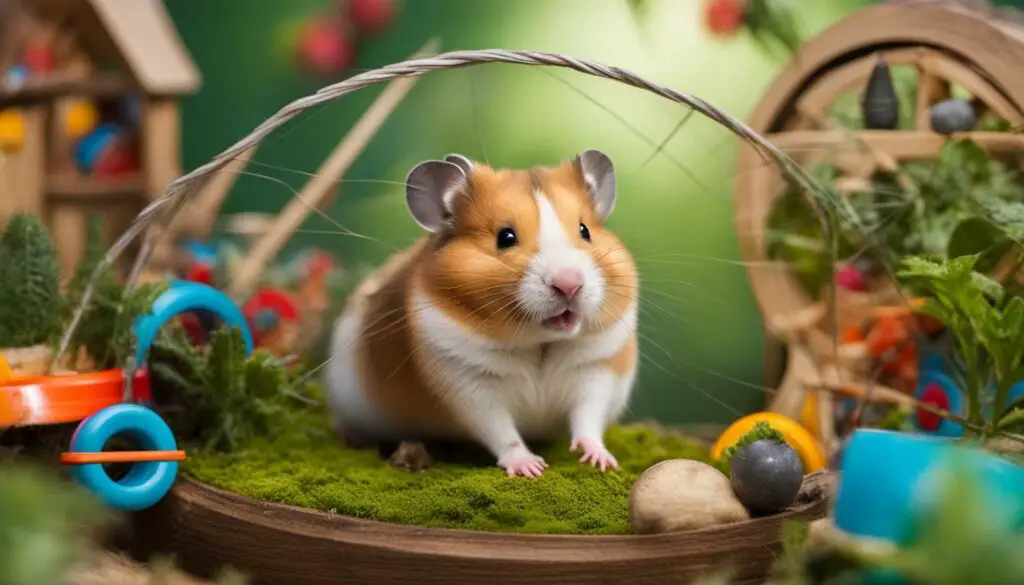
| Types of Exercise for Hamsters |
|---|
| Hamster Wheel |
| A solid wheel with no gaps is ideal for hamsters to run on and get their daily exercise. |
| Hamster Ball |
| Allowing your hamster to roll around in a hamster ball under supervision can provide them with a change of scenery and exercise. |
| Tunnels and Tubes |
| Providing tunnels and tubes for your hamster to explore and run through can stimulate their natural instincts and keep them active. |
| Obstacle Courses |
| Creating obstacle courses using safe materials like cardboard can challenge your hamster’s agility and keep them entertained. |
| Interactive Toys |
| Toys that encourage your hamster to climb, forage, or solve puzzles can provide mental stimulation and exercise. |
| Playpen |
| Allowing your hamster to explore a secure playpen outside of their cage provides them with a larger space to run and play. |
Proper Housing and Care
Providing the right housing and care for your hamster is vital for their well-being and can contribute to a longer lifespan. When it comes to hamster cages, size matters. Hamsters need plenty of space to explore, exercise, and exhibit their natural behaviors. A cage that is too small can lead to stress, boredom, and even health issues.
It is recommended to choose a cage that is at least 360 square inches in size for a single hamster. This will provide ample room for them to move around and engage in their natural activities such as running, climbing, and burrowing. Avoid cages with wire floors as they can cause injuries to your hamster’s feet. Opt for solid flooring or use safe, substrate bedding to create a comfortable and clean environment.
Regular cleaning is essential for maintaining a hygienic and healthy living environment for your hamster. Remove any soiled bedding and waste daily, and clean the cage thoroughly on a weekly basis. Use a pet-safe disinfectant to ensure the elimination of bacteria and odors. Keeping the cage clean will help prevent the build-up of harmful substances and reduce the risk of infections or respiratory problems.
| Cage Size Recommendations | Minimum Dimensions |
|---|---|
| Syrian Hamster | At least 360 square inches |
| Dwarf Hamster | At least 240 square inches |
| Roborovski Hamster | At least 240 square inches |
“The size of the cage is crucial for hamsters’ physical and mental well-being. It allows them to exhibit their natural behaviors and reduces the risk of stress-related issues.”
Providing your hamster with suitable housing and maintaining proper cleanliness is essential for their overall health and well-being. Ensure they have enough space to explore and exercise, and regularly clean their cage to prevent the build-up of harmful substances. By prioritizing your hamster’s housing and care needs, you can contribute to their longevity and ensure they live a happy and healthy life.
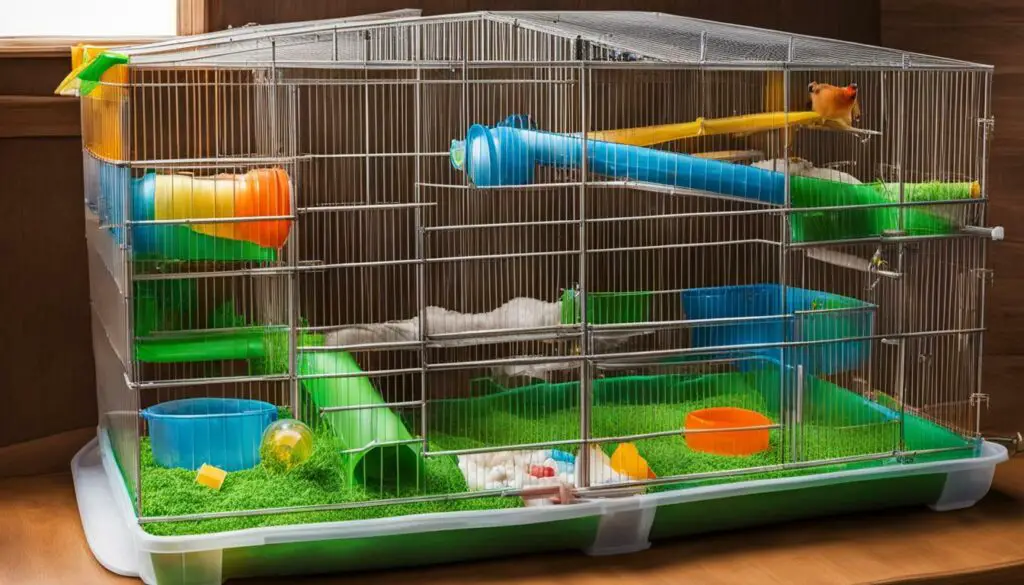
- Choose a cage that provides ample space for your hamster to move around and engage in natural behaviors.
- Opt for a cage with solid flooring or use safe bedding to ensure your hamster’s comfort.
- Clean the cage regularly to maintain a hygienic environment and prevent the build-up of harmful substances.
- Recommended minimum cage sizes for hamsters: Syrian Hamster – at least 360 square inches, Dwarf Hamster – at least 240 square inches, Roborovski Hamster – at least 240 square inches.
Remember, a well-cared-for hamster is a happy hamster with the potential for a longer lifespan.
Regular Veterinary Check-Ups
Just like any other pet, hamsters can benefit from regular veterinary check-ups to ensure they live a long and healthy life. While hamsters may seem small and low-maintenance, it’s important to monitor their health and catch any potential issues early on. Regular check-ups with a knowledgeable exotic pet veterinarian can help provide the necessary care and attention your furry friend needs.
During a veterinary check-up, the veterinarian will perform a thorough examination of your hamster, checking their overall health and well-being. They may check their weight, teeth, fur, and nails, as well as listen to their heart and lungs. They can also provide you with advice on proper nutrition, exercise, and general care for your hamster.
Regular veterinary check-ups not only ensure that your hamster receives appropriate medical attention, but they also help to prevent and detect any potential health issues early on. By staying proactive in your pet’s healthcare, you can help increase their lifespan and provide them with the best possible quality of life.
| Benefits of Regular Veterinary Check-Ups for Hamsters |
|---|
| Early detection of health issues |
| Professional guidance on nutrition and care |
| Monitoring weight and overall health |
| Prevention of potential health problems |

Visiting the veterinarian can be stressful for your hamster, but there are steps you can take to make the experience more positive. Start by acclimating your hamster to their carrier or travel box ahead of time, creating a safe and familiar space for them. Offer treats and positive reinforcement during and after the visit to help associate the veterinarian with positive experiences.
Additionally, be sure to choose a veterinarian who specializes in or has experience with exotic pets, such as hamsters. They will have the necessary knowledge and understanding of the unique needs of small animals.
Remember, regular veterinary check-ups are an integral part of responsible pet ownership. By providing your hamster with proper medical care, you can ensure they live a long and happy life by your side.
Conclusion
By considering various factors such as genetics, diet, exercise, and overall care, you can help increase your hamster’s lifespan and enjoy many happy years together.
When it comes to hamsters, the Syrian breed tends to live the longest among pet hamsters. These adorable creatures can live up to 2-3 years if provided with proper care. The European hamster, also known as the Black-Bellied or Common Hamster, has the longest lifespan in captivity, living up to 8 years. However, they are not commonly kept as pets.
If you’re looking for a pet hamster with exceptional longevity, consider the Roborovski Hamster. These tiny creatures have the longest lifespan among pet hamsters, with an average of 26 months in captivity. Their small size and fast heart rate contribute to their relatively shorter lifespan compared to other animals.
While hamsters are generally known for their short lifespans, there are ways to help extend their time with you. Providing a well-balanced diet, access to fresh water, and a suitable exercise space can greatly contribute to their overall health and longevity. Ensuring a proper cage size and cleanliness is also crucial for their well-being.
Regular veterinary check-ups are essential to detect any potential health issues early on. Finding a knowledgeable exotic pet veterinarian and scheduling routine check-ups can help ensure your hamster’s well-being and increase its lifespan.
By implementing these factors and providing the right care, you can give your hamster the best chance at a longer, healthier life. Cherish the moments you have together and create a loving environment that supports their well-being. Remember, your hamster’s happiness and longevity are in your hands.
FAQ
Which hamster breed tends to live the longest?
The Syrian breed tends to live the longest among pet hamsters.
What is the lifespan of the European hamster?
The European hamster, also known as the Black-Bellied or Common Hamster, has the longest lifespan in captivity, living up to 8 years. However, they are not commonly kept as pets.
Which hamster breed has the longest lifespan among pet hamsters?
The Roborovski Hamster is known to have the longest lifespan among pet hamsters, with an average of 26 months in captivity.
Why don’t hamsters live very long?
Hamsters generally don’t live very long due to their small size and fast heart rate. However, there are exceptions.
What factors can affect a hamster’s lifespan?
Factors such as genetics, diet, exercise, and overall care can affect a hamster’s lifespan.
What should I feed my hamster to increase its lifespan?
Providing a well-balanced diet is essential for a hamster’s longevity. Ensure they have access to fresh water and feed them a diet that includes a mix of hamster pellets, fresh fruits and vegetables, and occasional treats.
How can I provide ample exercise for my hamster?
Create an exercise space for your hamster with tunnels, wheels, and toys. Allow them supervised time outside their cage to explore in a safe environment.
What should I consider for proper housing and care of my hamster?
Provide a cage that is large enough for your hamster to move around comfortably, keep it clean and hygienic, and ensure they have access to bedding, hiding spots, and toys to keep them mentally stimulated. Regularly check for signs of illness or injury.
How often should I take my hamster to the veterinarian?
Regular veterinary check-ups are important to ensure your hamster’s overall health. Schedule annual visits with a knowledgeable exotic pet veterinarian.

